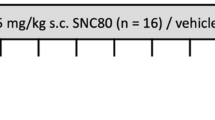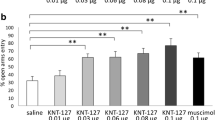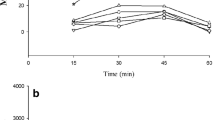Abstract
The possible role of opioid receptor heterogeneity in the biphasic changes in locomotion (activation and inhibition) induced by non-selective opiates such as morphine, has been investigated by measuring the behaviour of rats exposed to different environments after injection into the ventral tegmental area, of selective μ (DAGO) or δ (DTLET, DSTBULET, BUBU) opioid agonists and of kelatorphan, a complete inhibitor of enkephalin metabolism. δ agonists or kelatorphan-induced hyperactivity in a familiar (actimeter), unfamiliar (four-hole box) and a fear inducing (open-field) environment. These effects were suppressed by naloxone and δ selective antagonists (ICI 174, 864 2 mg/kg SC, naltrindole 7 nmol in the ventral tegmental area). Moreover, the δ agonists and endogenous enkephalins protected by kelatorphan did not affect the emotional state of rats measured in an elevated plus maze. Infused into the ventral tegmental area, DAGO also enhanced locomotion in the actimeter but in contrast to δ agonists and kelatorphan, the μ agonist decreased activity in the open-field and the four-hole box. The hypoactivity observed in these tests could be related to an enhanced emotionality produced by μ receptor stimulation, as shown by the significant decrease in the number of visits and time spent in open arms of the elevated plus maze. Naloxone (0.3 mg/kg SC) but not δ selective antagonists, blocked the various responses induced by DAGO.
Similar content being viewed by others
References
Bozarth MA, Wise RA (1980) Intracranial self-administration of morphine into the ventral tegmental area. Life Sci 28:551–555
Britt MD, Wise RA (1981) Opiate rewarding action: independence of the cells of the lateral hypothalamus. Brain Res 222:213–217
Broekkamp C, Phillips A, Cools A (1979) Stimulant effects of enkephalin microinjection into the DA A10. Nature 278:560–562
Cador M, Kelley AE, Le Moal M, Stinus L (1988)d-Ala-Metenkephalin injection into the ventral tegmental area: effect on investigatory and spontaneous motor behaviour in the rat. Psychopharmacology 96:332–342
Cotton R, Giles MG, Miller L, Shaw JS, Timms D (1984) ICI 174 864: a highly selective antagonist for the opioid δ receptor. Eur J Pharmacol 97:331–332
Daugé V, Rossignol P, Roques BP (1988) Comparison of the behavioural effects induced by administration in rat nucleus accumbens or nucleus caudatus of selective μ and δ opioid peptides or kelatorphan an inhibitor of enkephalin-degrading-enzymes. Psychopharmacology 96:343–352
Daugé V, Rossignol P, Roques BP (1989) Blockade of dopamine receptors reverses the behavioural effects of endogenous enkephalins in the nucleus caudatus but not in the nucleus accumbens: differential involvement of δ and μ opioid receptors. Psychopharmacology 99 [2] 168–176
Delay-Goyet P, Seguin C, Gacel G, Roques BP (1988) [3H] [d-Ser2(O-tert-butyl), Leu5] Enkephalyl-Thr6(O-ter-butyl). Two new enkephalin analogs with both a good selectivity and a high affinity toward δ-opioid binding sites. J Biol Chem 263 [9]:4124–4131
Delay-Goyet P, Zajac JM, Roques BP (1990) Improved quantitative radioautography of rat brain δ opioid binding sites using [3H] DSTBULET, a new highly potent and selective linear enkephalin analogue. Neurochem Int 16 [3]:341–368
Deutch AY, Maggio JE, Bannon MJ, Kalivas PW, Tam SY, Goldstein M, Roth RH (1985) Substance K and substance P differentially modulate mesolimbic and mesocortical systems. Peptides 6 [Suppl 2]:113–122
De Witte Ph, Heidbreder C, Roques BP (1989) Kelatorphan, a potent enkephalinases inhibitor and opioid receptor agonists DAGO and DTLET, differentially modulate self stimulation behaviour depending on the site of administration. Neuropharmacology 28[7]:667–676
Dilts RP, Kalivas PW (1989) Autoradiographic localization of μ-opioid and neurotensin receptors within the mesolimbic dopamine system. Brain Res 488:311–327
Elliot PJ, Alpert JE, Bannon MJ, Iversen SD (1986) Selective activation of mesolimbic and mesocortical dopamine metabolism in rat brain by infusion of a stable substance P analogue into the ventral tegmentum. Brain Res 363:145–147
Fournié-Zaluski MC, Chaillet P, Bouboutou R, Coulaud A, Chérot P, Waksman G, Costentin J, Roques BP (1984) Analgesic effects of kelatorphan, a new highly potent inhibitor of multiple enkephalin degrading enzymes. Eur J Pharmacol 102:525–528
Gacel G, Daugé V, Breuzé P, Delay-Goyet P, Roques BP (1988) Development of conformationally constrained linear peptides exhibiting a high affinity and pronounced selectivity for δ-opioid receptors. J Med Chem 31:1891–1897
Gaspar P, Berger B, Gay M, Hamon M, Cesselin F, Vigny A, Javoy-Agid F, Agid Y (1983) Tyrosine hydroxylase and metenkephalin in the human mesencephalon: immunohistochemical localization and relationships. J Neurol Sci 58:247–267
Glimcher PW, Giovino AA, Margolin DH, Hoebel BG (1984) Endogenous opiate reward induced by an enkephalinergic inhibitor, thiorphan, injected into the ventral midbrain. Behav Neurosci 98:262–268
Gray JA (1982) The Neuropsychology of anxiety. Oxford Psychology Series, Oxford University Press, New York
Haber S, Elde R (1982) The distribution of enkephalin immunoreactive fibers and terminals in the monkey central nervous system. An immunohistochemical study. Neuroscience 7:1049–1095
Hall CS (1934) Emotional behaviour in the rat: I Defecation and urination as measures of individual differences in emotionality. J Comp Psychol 18:385–403
Handa BK, Lane AC, Lord JAH, Morgan BA, Rance MJ, Smith CFC (1981) Analogues of beta-L.P.H. 61–64 possessing selective agonist of mu-opiate receptors. Eur J Pharmacol 70:531–541
Haveman U, Kuschinsky K (1985) Locomotor activity of rats after injection of various opioids in the nucleus accumbens and the septum medial. Naunyn Schmiedeberg's Arch Pharmacol 331:175–180
Heidbreder C, Roques B, Vanderhaeghen JJ, De Witte Ph (1988) Kelatorphan, a potent enkephalinases inhibitor, presents opposite properties when injected intracerebroventricularly or into the nucleus accumbens on intracranial self stimulation. Neurochem Int 12:347–350
Hoebel BG, Novin D (eds) (1982) The neural basis of feeding and reward. Haer Institute Brunswick, Me
Holson HR (1986) Medial prefrontal cortical lesions and timidity in rats. I. Reactivity to aversive stimuli. Physiol Behav 37:221–230
Joyce EM, Koob GF, Strecker R, Iversen S, Bloom FE (1981) The behavioural effects of enkephalin analogues injected into the ventral tegmental area and globus pallidus. Brain Res 221:359–370
Kalivas PW (1985) Interactions between neuropeptides and dopamine neurons in the ventro-medial mesencephalon. Neurosci Behav Rev 9:573–587
Kalivas PW, Bronson M (1985) Mesolimbic dopamine lesions produce an augmented behavioural response to enkephalin. Neuropharmacology 24 [10]:931–936
Kalivas PW, Richardson-Carlson R (1986) Endogenous enkephalin modulation of dopamine neurons in the ventral tegmental area. Am J Physiol 258:243–249
Kalivas PW, Abhold R (1987) Enkephalin release into the ventral tegmental area in response to stress: modulation of mesocorticolimbic dopamine. Brain Res 414:339–348
Kalivas PW, Widerlov E, Stanley D, Breese G, Prange PR (1983) Enkephalin action on the mesolimbic system, a dopamine dependent and dopamine independent increase in locomotor activity. J Pharmacol Exp Ther 227[1]:229–235
Katz RJ, Manik CP (1984) Endogenous opiate and stress. Behavioral activation elicited in the rat and effects of naltrexone, diprenorphine and morphine. Neuropharmacology 23 [12A]:1425–1430
Kelley A, Stinus L, Iversen S (1980) Interactions betweend-Alamet enkephalin A 10 dopaminergic neurons and spontaneous behaviour in the rat. Behav Brain Res 1:3–24
Latimer LG, Duffy P, Kalivas PW (1987) Mu opioid receptor involvement in enkephalin activation of dopamine neurons in the ventral tegmental area. J Pharmacol Exp Ther 241 [1]:328–337
Maldonado R, Daugé V, Feger J, Roques BP (1990) Chronic blockade of D2 but not D1 dopamine receptor facilitates behavioural responses to endogenous enkephalins, protected by kelatorphan, administered in the accumbens in rats. Neuropharmacology 29 [3]:215–223
Mansour A, Khachaturian H, Lewis ME, Akil H, Watson SJ (1987) Autoradiographic differentiation of mu, delta and kappa opioid receptors in the rat forebrain and midbrain. J Neurosci 7 [8]:2445–2464
Markowska A, Lukaszewska I (1980) Emotional reactivity after frontomedial cortical, neostriatal or hippocampal lesions in rats. Acta Neurobiol Exp (Warsz) 40 [5]:881–893
Montgomery KC (1955) The relation between fear induced by novel stimulation and exploratory drive. J Comp Physiol Psychol 48:254–260
Mosberg HI, Hurst R, Hruby VJ, Gee K, Yamamura HI, Calligan JJ, Burks TF (1983) Bis-penicillamine enkephalins possess highly improved specificity toward δ opioid receptors. Proc Natl Acad Sci USA 80:5871–5874
Nabeshima T, Katoh A, Hiramatsu M, Kameyama T (1986) A role played by dopamine and opioid neuronal systems in stress-induced motor suppression (conditioned suppression of motility) in mice. Brain Res 398:354–360
Paxinos G, Watson C (1982) The rat brain in stereotaxic coordinates. Academic Press, Sydney
Pellow S, Chopin P, File SE, Briley M (1985) Validation of open: closed arm entries in an elevated plus-maze as a measure of anxiety in the rat. J Neurosci Methods 14:149–167
Phillips AG, Le Piane FG (1982) Reward produced by microinjection of (d-ala)-met enkephalinamide into the ventral tegmental area. Behav Brain Res 5:225–229
Portoghese PS, Sultana M, Nagase H, Takemori AE (1988) Application of the message-address concept in the design of highly potent and selective non peptide δ opioid receptor antagonists. J Med Chem 31 [2]:281–282
Robbins TW, Everitt BJ (1982) Functional studies of the central catecholamines. Int Rev Neurobiol 23:303–365
Roques BP, Fournié-Zaluski MC, Soroca E, Lecomte JM, Malfroy B, Llorens C, Schwartz JC (1980) The enkephalinase inhibitor thiorphan shows antinociceptive activity in mice. Nature 288:286–288
Roques BP, Daugé V, Gacel G, Fournié-Zaluski MC (1985) Selective agonists and antagonists of delta opioid receptors and inhibitors of enkephalins metabolism. Potential use in treatment of mental illness. Biological Psychiatry. Developments in Psychiatry 7:287–289, Elsevier Science Publishing Co., New York
Stein L, Belluzzi JD (1978) Brain endorphins and sense of well-being: a psychobiological hypothesis. In: Costa E, Trabucchi J (eds) Advances in biochemical pharmacol, vol 18. Raven Press, New York, pp 299–311
Stinus L (1982) Interaction entre systèmes peptidergiques opioïdes et neurones dopaminergiques mésolimbiques: analyse comportementale. Actualités chimie thérapeutique, 2ème série technique et documentation Lavoisier, pp 275–284
Taghzouti K, Simon H, Louilot A, Herman JP, Le Moal M (1985) Behavioural study after local injection of 6-OHDA into the nucleus accumbens in the rat. Brain Res 344:9–20
Waksman G, Hamel E, Fournié-Zaluski MC, Roques BP (1986) Autoradiographic comparison of the distribution of the neutral endopeptidase enkephalinase and of mu and delta receptors in rat brain. Proc Natl Acad Sci USA 83 [5]:1523–1527
Walsh RN, Cummins RA (1976) The open-field test: a critical review. Psychol Bull 83 [3]:482–504
Wise RA (1983) Brain neuronal systems mediating reward processes. In: Smith JE, Lane JD (eds) Neurobiology of opiate reward processes. Elsevier/North Holland Biomedical Press, Amsterdam, pp 405–437
Zajac JM, Gacel G, Petit F, Dodey P, Rossignol P, Roques BP (1983) Deltakephalin, Tyr-d-Thr-Gly-Phe-Leu-Thr: a new highly potent and fully specific agonist for opiate δ-receptors. Biochem Biophys Res Commun 111 [2]:390–397
Author information
Authors and Affiliations
Rights and permissions
About this article
Cite this article
Calenco-Choukroun, G., Daugé, V., Gacel, G. et al. Opioid δ agonists and endogenous enkephalins induce different emotional reactivity than μ agonists after injection in the rat ventral tegmental area. Psychopharmacology 103, 493–502 (1991). https://doi.org/10.1007/BF02244249
Received:
Revised:
Issue Date:
DOI: https://doi.org/10.1007/BF02244249




